

EAP Publications | Virtual Library | Magazine Rack | Search | What's new
Join the Ecological Solutions Roundtable
Joseph Kovach, Harvey Reissig, and Jan Nyrop New York State Agric. Expt. Sta, Geneva, NY
This article is reprinted from a 1989 report . It is in the form used for scientific reports, and is largely unedited The effect of botanical insecticides will be a major concern to organic apple producers. However, as the authors point out, these materials may not be low-input or sustainable, even if they do fulfill organic criteria
In the last year or so fruit growers in N.Y. have shown an interest in growing "organically" approved apples. Because some botanical insecticides are currently recognized as acceptable under a regulated status by he National Organic Farmer Association of New Yolk Inc. (NOFA-NY), efficacy data needed to be developed for these pesticides in order to provide the best information possible to N.Y. growers.
There are a number of rules associated with being certified organic by NOFA-NY:
1. No synthetic pesticides can be used in the block for the last 3 years;
2. The same sprayer can't be used to apply organically approved pesticides that was used to apply synthetic pesticides and;
3. Certain elemental, botanical or biological pesticides are acceptable under a regulated category by NOFA-NY.
In this study, we examined some of the impacts of rule 3. Some of the approved fungicides include compounds that contain copper or sulfur. Approved insecticides and miticides include, oil, Dipel (Bacillus thuriengensis or BT), rotenone(a ground root of cube imported from Peru), pyrenthrin (seeds of chrysanthemum flowers from Kenya) and ryania (stemwood of the shrub Ryania from South America). Sabadilla is another organic insecticide option, but was not included in the field studies because it is not registered in NY state.
The purpose of this test was not to produce an organically certified block. We were just looking at the effectiveness of organic materials. This meant that the first two rules did not apply, and we did not follow them.
There were three objectives in this study.
To address these objectives, 3 experiments were conducted independently. Their methods and results will be discussed separately.
Experiment 1: Effectiveness of ryania, and a rotenone-pyrethrin mixture on NY apple pests used on a full schedule in a standard sized orchard with severe insect pressure.
Methods: Two botanical insecticide treatments were compared to a standard synthetic insecticide treatment and a non-sprayed check. Treatments were arranged in a randomized complete block design (a standard statistical way to arrange treatments). We used single-tree plots of standard sized 'McIntosh and 'Cortland' trees. All sprays were applied as dilute sprays and applied to Runoff with a hand sprayer (4.50 psi'). 'Synthetic fungicides were applied to the whole block when needed.
The synthetic insecticide treatment, Guthion@, was applied on a 14 day schedule starting at petal fall (I rune), and including 6 cover sprays. The botanical insecticides, rotenone pyrethrin and ryania, were applied at petal fall ( I June) and at weekly intervals thereafter. Check trees were not sprayed with any insecticide.
During harvest(6- 13 September), 100 apples from each tree were evaluated for insect damage. In addition, European red mites and the predaceous mites Typholodromus pyri and Zetzellia mali were sampled on 25 randomly selected leaves from each of the plots on 12 July,25 July, and 14 August. Aphids were counted on the distal leaves on 5 growing terminals tree on July 26. On 28 August, spotted tentiform leaf miner (STLM) tissue mines were counted on 20 randomly selected fruit cluster and white apple leaf hoppers (WALH) were counted on 25 randomly selected spur leaves on each tree.
Results: The weekly schedule of rotenone-pyrethrin was effective against the foliar feeders and rosy apple aphid (RAA), but did not adequately control the plum curculio (PC) or apple maggot (AM). the weekly sprays of ryania provided excellent control `,f; the foliar feeders and intermediate lepidopterans.(a . complex of codling moth, oriental fruit moth, and; lesser apple worm). However, this material was not effective against either the PC, AM, or San Jose scale (SJS). Population of both ERM and predaceous mites were extremely low in all of the plots throughout the season and differences among the treatments and the check plot were generally not statistically significance The cost of the insecticides were only material costs and did not include application costs. While most growers would not apply and could not afford a full season program of the botanical insecticides, we felt it was important to include the costs for comparison purposes. For reference, commercial growers in NY who use synthetic fungicides, miticides and insecticides for season long pest control generally spend under $200/A.
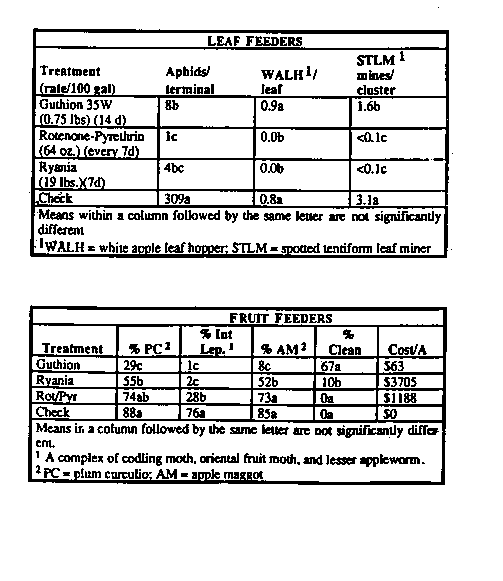
Experiment 2: Effect of botanicals on the predatory mite Typholdromus pyre
Methods: We attempted to directly measure the effect of 3 botanical insecticide treatments, ryania, Sabadilla, and rotenone-pyrethrin, on predator mites. In each treatment five leaves were sprayed with one of the test materials and allowed to dry. Five predator mites, T. pyri, were placed on each leaf and after 48 hours the number of dead mites was recorded.
Results: Ryania does not seem to be toxic to T. pyre The rotenone-pyrethrin mixture was moderately toxic. Sabadilla was extremely toxic to this predatory mite

Experiment 3 - Minimal "organic" spray program with a trap out strategy for apple maggot in a disease resistant apply planting.
Methods: A 9-year-old planting, containing numerous disease resistant cvs., was used for this experiment. This planting consisted of cat 550 dwarf apple trees on M26 rootstock (TRV=170 gal dilute). Cvs. included 'Liberty', 'Freedom', 'Pricilla', several unnamed, NY numbered disease resistant cvs., 'McIntosh' and Rome. No fungicides were applied to one half of planting throughout the season. The remaining half of the planting received one dormant application of COCS (late April) to preliminarily assess this strategy for summer disease control in scab resistant apples.
Insecticide treatments were applied in a randomized complete block design with each block containing 24-30 trees. Half the blocks received a herbicide treatment with the remaining blocks receiving a 4" layer of wood chips in late April for weed control.
Treatments for early season pest control (plum curculio, codling moth, fruit worms and leafrollers) consisted of the fallowing. 1)a dilute sprays of Imidan at petal fall (5/31); 2) ryania at PF (5/31 ) and 8 days later (6/8); and 3) rotenone-pyrethrin at PF (5/31), 4 days later (6/ 4), and again 5 days (6/9).
European red mites were sampled on 6/15 and 7/14 by examining 20 leaves/block and recording the proportion of leaves infested with mites.
Two of the blocks received a rotenone pyrethrin spray on 7/21 to assess leafroller control The presence of other pests was noted when observed. Summer oblique banded leafroller larvae were sampled on 7/l8 and 7/24 by examining 25 terminals per block and recording the percent infested terminals
Apple maggot treatments were arranged in a randomized complete block design with each block containing 35 trees and each treatment being replicated 4 times. Treatments for apple maggot included l) placing non-baited apple maggots sphere on the outside rows of trees around the treatment blocks (ringing); and 2) applying Imidan at peak emergence (8/l5). Harvest evaluations were conducted (9/l5 ,9/2l) by sampling 100 apples per block (choosing 'Liberty' wherever possible) and recording insect damage.
Results: Eighteen different pest species were observed in the main experimental block. Most of these pest occurrences were at or below treatment levels and did not appear to cause significant injury to the fruit or leaves. Pests that did cause fruit damage are listed below.
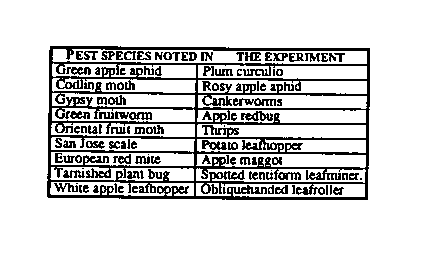
Early season control. For early season pest control,3 sprays of rotenone-pyrethrin at 5 day intervals is equivalent to one spray of Imidan(3. Ryania was not very effective in controlling the early season pests in this block. Again, the cost of botanicals was high but not nearly as expensive on dwarf trees as on standard trees.
Because the plum curculio season was extended in 1989 another Imidan or 3 more rotenone-pyrethrin sprays should have been applied to give us better control of this pest. If this strategy were used, we feel that greater than 70% clean fruit could have been produced this year. For comparison, 30% clean apples seems to be the best that commercial organic growers can produce under current NY conditions, when growing scab susceptible cvs..In orchards where synthetic pesticides are used, 90 to 95% clean apples is the commercial standard.
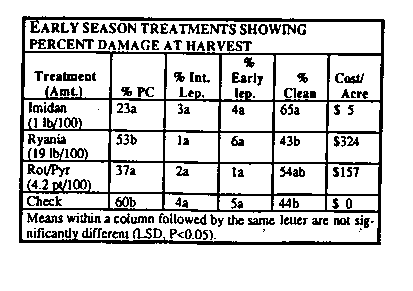
In one surprising result, significantly more plum curculio oviposition and feeding damage was found in the mulched blocks than the non-mulched blocks. Reasons for this are unknown.
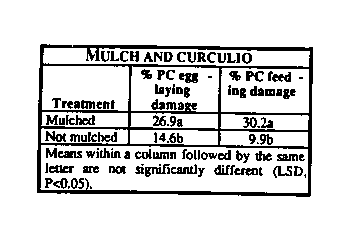
Mid season pests Because lab experiments showed that the rotenone-pyrethrin treatment affected predatory mites, and the ryania treatment did not, it might have been expected that rotenone-pyrethrin would lead to more European red mite (ERM) damage in the field. However, the early season applications of these compounds did not flare ERM populations in this planting. ERM counts were low throughout the season with less than 490 of the leaves being infested with mites on 7/14 across all treatments.
The rotenone-pyrethrin treatment did provide some control of obliquebanded leafroller. However, other studies conducted in NY in 1989 have shown that a Dipel application at peak egg hatch provides as good control of summer obliquebanded leafroller as any of the other currently registered synthetic pesticides. Because Dipel appears to be more effective, and the cost of the botanicals is higher, Dipel should be if,. pesticide of choice in organic orchards when control of obliquebanded leafroller is needed.
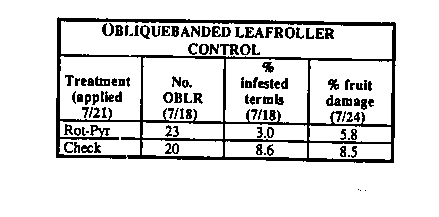
Late season treatments: Because this block had little to no apple maggot pressure in 1989, this phase of the study needs to be repeated in 1990.
What does this mean for sustainable and organic apple production ? It is possible to grow clean NOFA-NY certified organic apples in NY if disease resistant cvs. are used, scrupulous orchard sanitation is practiced end at least 6-7 sprays of botanical insecticides are applied for pest control. A recommended spray -schedule to achieve 7~75% clean "organic" applies would include 5-6 sprays of rotenone-pyrethrin every 5 days sting at petal fall to control early season pests, an application of Dipel in mid July to control leafroller and an application of ryania in mid to late August to control codling moth (if pressure is severe), and 1 sphere/100 apple for maggot control. -:We estimate that the cost of this program in a dwarf disease resistant planting using 1989 prices would be $314/A for early season control with rotenone-pyrethrin, $162/A for ryania and $210/A for apple maggot control based on 600 bu/A). Total cost of the program would be $685/A. A 4 spray program using the synthetic pesticide Imidan would cost about $20/A and would result in over 90% clean fruit.
A question that arises from doing this type of research is whether the organic approach is more environmentally sound than an IPM approach using soft chemicals. Does 6 applications of rotenone-pyrethrin have less impact on the environment than 2 Imidan applications? These questions need to be addressed if botanical insecticides are continued to be allowed in organic certifiable programs.
Because little or no fungicides were applied to control fruit diseases in this block, many fungal insect pathogens were observed throughout the year and in fact provided some biological insect control. Little information is available on this type of biological control agent for controlling our difficult N.Y. orchard pests. Further work needs to be conducted in this area.
Copyright © 1989.
Info Request | Services | Become EAP Member | Site Map
Give us your comments about the EAP site
Ecological Agriculture Projects, McGill University (Macdonald
Campus)
Ste-Anne-de-Bellevue, QC, H9X 3V9 Canada
Telephone:
(514)-398-7771
Fax:
(514)-398-7621
Email: eapinfo@macdonald.mcgill.ca
To report problems or otherwise comment on the structure of this site, send mail to the Webmaster